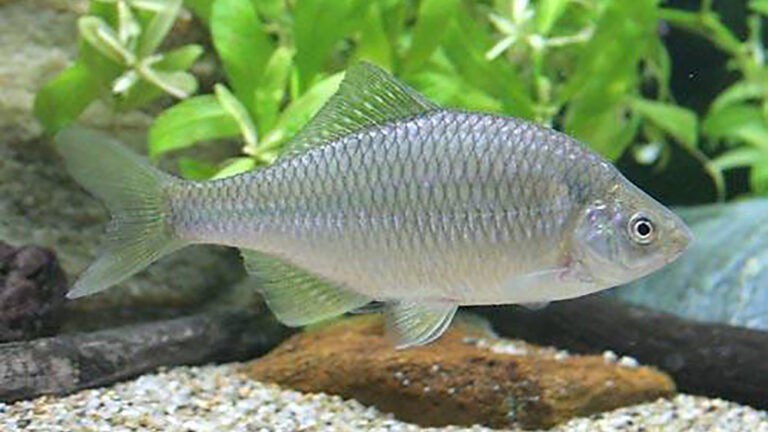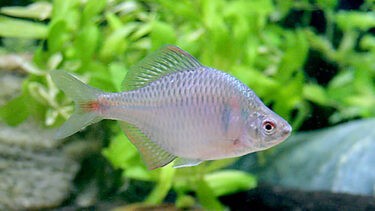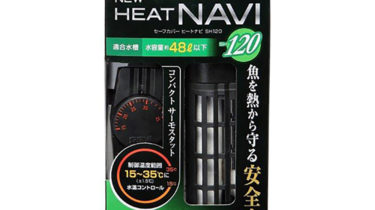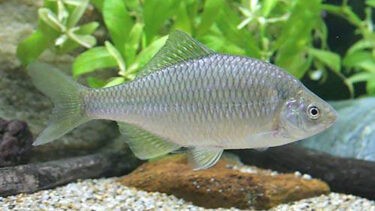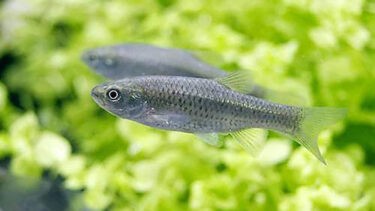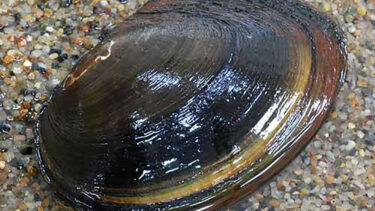The kanehira is a river fish with a bright silvery-white body color and blue-green inverted triangle-shaped spots on the back of the gills. It is also one of the larger species in the tanago genus. In this article, I would like to explain in detail the characteristics of the kanaehira and how to keep it.
What is Kanehira?

The kanehira belongs to the family Cyprinidae of the carp family. The origin of the kannehira is Japan and the Korean Peninsula in East Asia. In Japan, it is found from the Nobi Plain west of Gifu and Aichi Prefectures to the northern part of Kyushu.In recent years, it has been found in non-traditional habitats. The kanehira has a high body height and a diamond-shaped appearance when viewed from the side. They also have a silvery-white body color and are characterized by a blue-green inverted triangular patch behind the gills.
The Nippon baratanago is a river fish with a bright rainbow-colored body color. It is an endangered species in some places. In this article, we will discuss the characteristics of the Nipponbaratanago and how to keep them [...].
The Tairiku rose tanago is native to southern China, Taiwan, and the Korean Peninsula in East Asia and belongs to the family Carpidae of the order Carpidae, and is a river fish with bright rainbow body colors. It is also currently listed as an "Invasive Alien Species Requiring Attention" by the Ministry of the Environment. In this article, we will discuss the Tairiku Bara-Tanago [...].
The aburabote is a blackish brown-colored river fish of the carp family, Carangidae, native to the area from the Nobi Plain west of Gifu and Aichi prefectures to northern Kyushu in Japan. It is also an endangered species in some places. In this article, we will discuss the [...].
How to keep a kanehira
Canechillas can be an easy species to keep if you know how to keep them. The life span of the kanaehira is about 3 to 4 years. Their body size is about 12 to 15 cm. However, both lifespan and body size vary depending on the environment in which they are kept and the food they are fed. They prefer slightly alkaline to neutral water quality, with a pH of 7.0 to 8.0. They can live in water temperatures between 5-25℃.
A heater is a device that maintains a constant water temperature. If you go to a specialty store that carries heaters, you will find a wide variety of types. Some people may be at a loss as to which one to choose. In this article, we would like to explain about such heaters [...]
Points to keep in mind when mixing swimmers
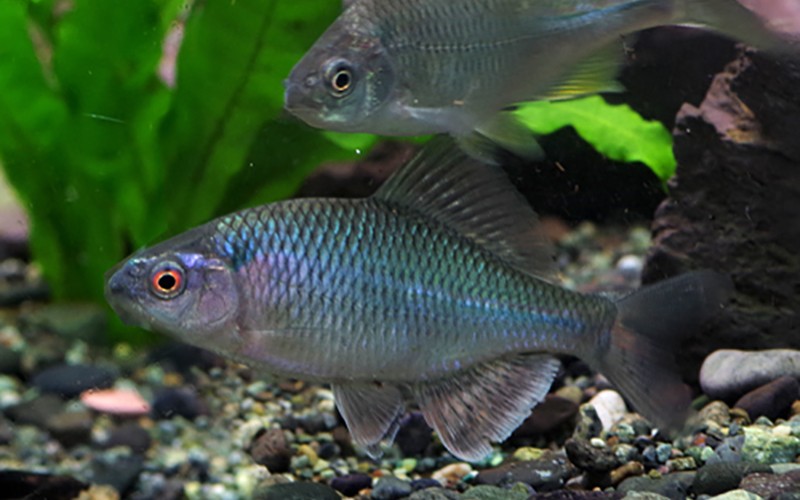
Regarding mixed swimming, the temperament of the kanehira is mild. However, it is recommended to mix them with medium-sized species, as they may chase smaller individuals.Smaller species of Tanago should not be mixed with the same species of Tanago. When it is time for breeding, they spawn on bivalves, but if they want to spawn on each other, they often fight and the smaller species may not be able to breed well. If you must include them in your breeding program, please be very careful.
Many people think that goldfish are the goldfish that you see at fairs and festivals in the summer, and that there are many different kinds of goldfish. And it is no exaggeration to say that each type of goldfish has its own characteristics, and that is the best part about goldfish [...]
When you go to a specialty store to look at killifish, you will be surprised at the many varieties available. The prices are different, as are the body colors and patterns, so it is hard to know what to choose. So, in this article, I would like to explain in detail about the different types of medaka. Types of Medaka Scarlet Medaka [...].
Points about spawning
Many people who keep canehillas want to breed them. In the wild, canephirs spawn in the spring. If they are kept in captivity, the timing when the water temperature reaches around 20 degrees Celsius is the signal for spawning. When it is time to spawn, the male produces iridescent nuptial colors on its back and abdomen. Females extend a black tube, called an oviduct, from near their rump.In some cases, the oviducts may be so long that they reach the tip of the tail fin.
Tanago lay their eggs on bivalves, whereas other ornamental fish such as killifish and goldfish lay their eggs on water plants. This spawning method is the biggest obstacle in trying to breed Tanago. This is because, unlike aquatic plants, you have to keep bivalves. If the bivalve that the bitterling spawned dies before the eggs hatch, the eggs will die with it. Another difficulty is that there are fewer specialty stores that deal in bivalves compared to aquatic plants. The types of bivalve mollusks used by bitterlings for spawning include the pine cone mussel, the dove mussel, the echinoderm oyster, and the mussel. If you are not sure, we recommend that you ask at a specialty store. If you want to breed bitterlings, the first step is to find bivalves.
When the bivalve is in the aquarium, the female lays her eggs in the gills of the shell using an egg tube. The male fertilizes the eggs by applying sperm to them immediately after the female lays them. The eggs hatch about 3-4 days after spawning, consume the yolk sac (nutrition received from the parents) in about a week, and grow to about 1 cm in about 20 days and emerge from the shell. At this time, the juvenile fish may have a shellfish baby attached to its fins. Just as the bitterling uses the shells, the shells use the bitterlings to expand their habitat. The male may protect the bivalves after laying eggs, but the fry are often eaten, so if you are keeping them in an aquarium, it is recommended to move the shells to another tank after confirming the spawning. Successful spawning of bitterling depends on how well you can keep the bivalves stable, so if you are worried about them or are not confident about handling them, we recommend that you purchase bivalves from a specialty store just before the bitterling spawns.
What to keep in mind when keeping a kanehira

The kanehira is a river fish characterized by its silvery-white body color and blue-green inverted triangular spots on the back of its gills. It is also one of the larger species in the tanago genus.Many people often have a hard time distinguishing them from other Tanago species when they see them sold at specialty stores. The first way to distinguish the kanehira is to have scales with a silvery body color. The kanehira has scales that are shiny and glittering at a glance. Other species have scales that are slightly darker. You may also recognize them by their size. Smaller specimens are not so easy to recognize, but larger specimens can be distinguished by their obvious difference in body length. If you are interested in Kanaehira, we recommend that you visit a specialty store and take a look.

